
To Be or Not to Be... Making It?
The question arises frequently for me, “Can I make a living at being an artisan?”
Ready to travel to the Julmarknad Sale at the Swedish Institute
A car stuffed with 100’s, likely 1000 small felted things, and still I felt there wasn’t ENOUGH! I discovered how wrong I was as I tried to gracefully balance everything onto one 6’ table for the American Swedish Institute Julmarknad, Holiday Sale. While preparing for the sale, the steady voice in my head was, “there isn’t enough”. Like an elf in Santa’s workshop, I was in a production frenzy. Not until I unpacked all of my boxes did I realize how much I had produced! There was one major fault in my booth, and this was that I had too much stuff! I look at the pictures now and I feel overwhelmed looking at how I crushed all of my felted goods onto a 6’ table, with an added 3’ table and a chair, overflowing with wooly goods.
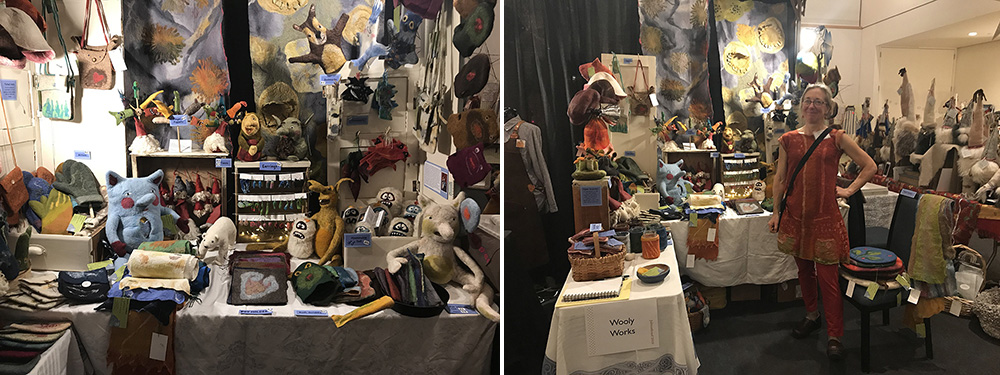
Too much stuff!; Ready for business
I worked steadily on preparing for this show during the early winter months, making and developing a number of new items. I was especially excited about creating a series of playful creatures. They are curious as a sales piece because they look like a stuffed animal but they are priced like they are a mantle piece.
New Friends
Here is one with photos of the whole process from the beginning of stuffing socks and wondering what it will become, to the final stage of sculpting and shaping it to have a specific expression. I called it Ochre, which is past tense, since the new owners have likely given it a new name. They have also requested a sibling creature to be made for their grown son who is obsessed with Ochre.
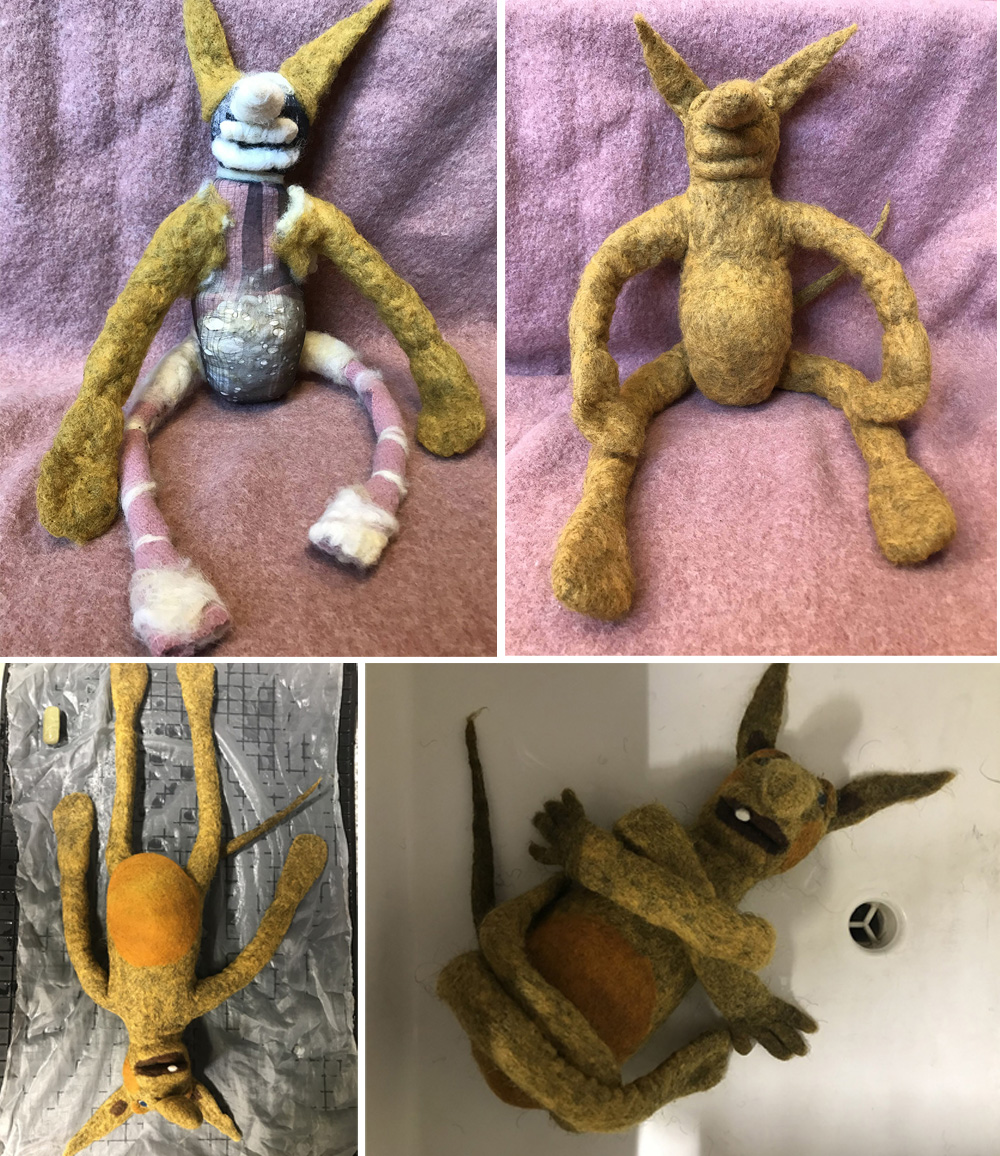
Ochre
The Julmarknad Sale was a time for learning, as it was my first Holiday Sale besides the annual holiday sale I hosted in my Minneapolis home, so many years ago, where I had the luxury of a house to display everything! At ASI, I was experimenting with what sells and what sits, who comes to the sale, what are they looking for, what do they want to spend. Then I ask myself, what does the world need, how can I be a part of positive consumption, offering items that are sturdy, made to last, beautiful and using materials that are environmentally/human friendly? I was told to make things that are blue and yellow and tomtens. There are so many questions and mysteries in the world of sales! There were a couple of things that I sold out of and a number of items that flopped.
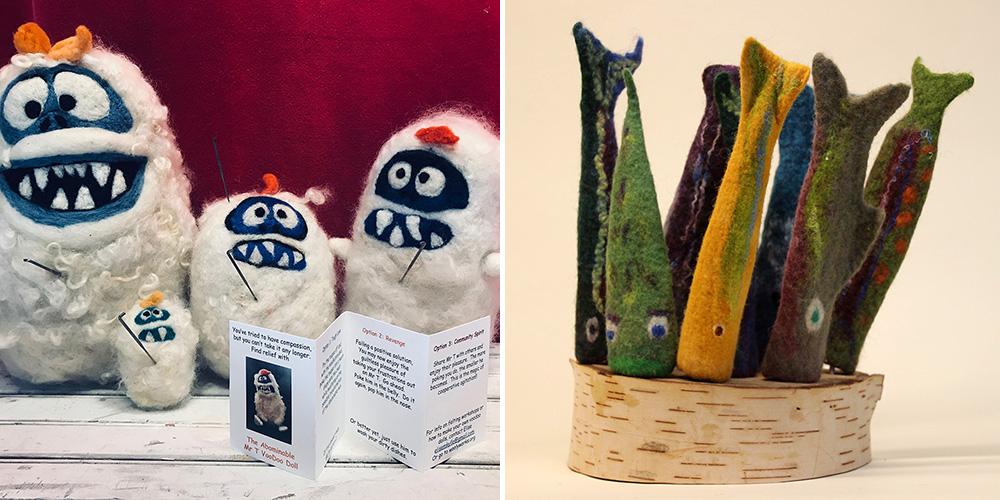
Best Sellers: The Abominable Mr T voo doo doll, or to some, a cute yeti; Pot holders, that look like fish
There were a few items that no one even picked up or seemed to notice. I wish I knew why. I thought they were practical, useful and beautiful….but no one else did. 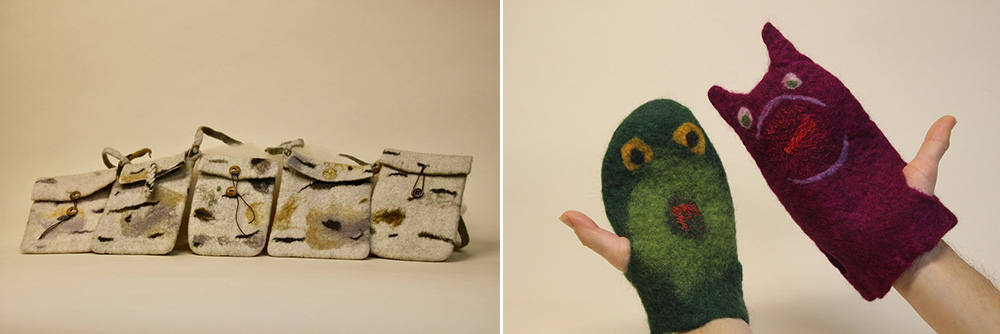
Worst Sellers: small bags; Bath scrubby puppets
I felt honored to be invited (I applied) to participate. Just as I expected, I was surrounded by a wonderful community of artisans and a super supportive ASI staff. There was a sweet clutch of North House Instructors set up in one corner of the hall, allowing for connection and communication with old friends. 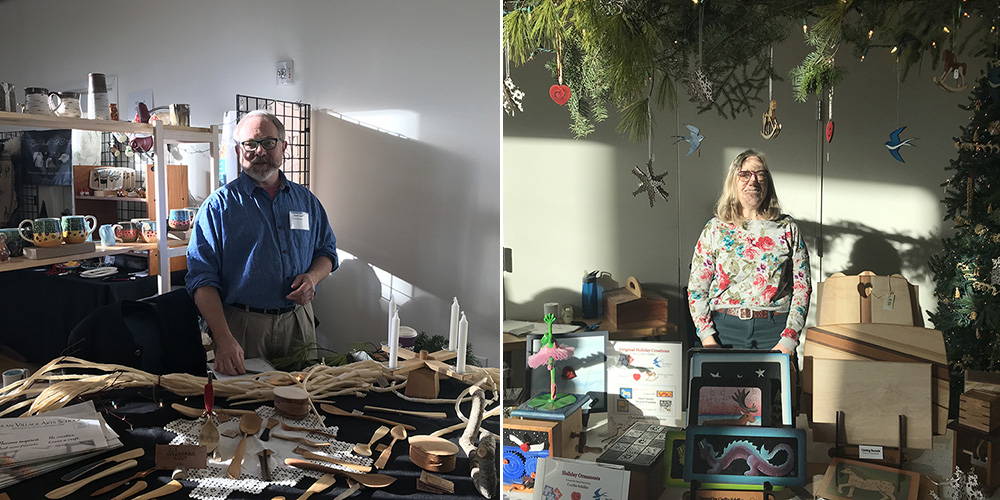
Fred Livesay; Cecilia Schiller
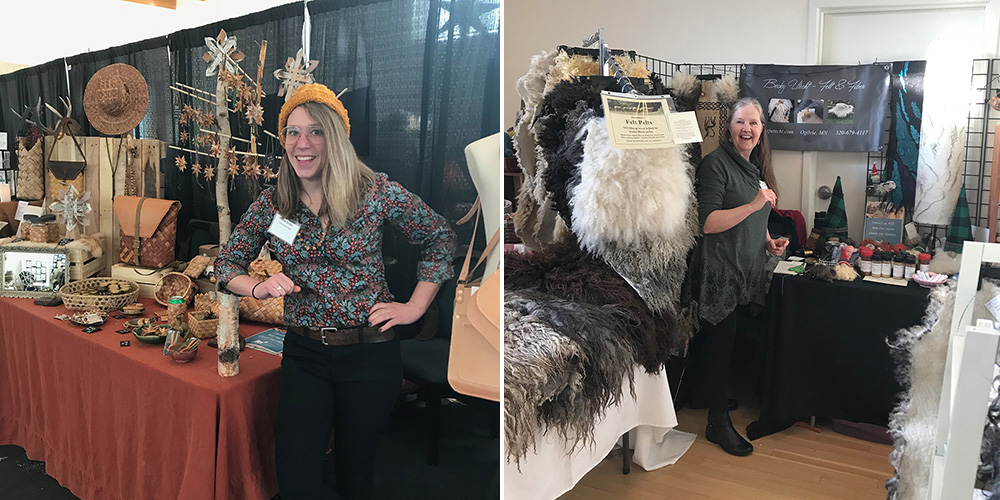
Beth Homa Kraus; Becky Utecht
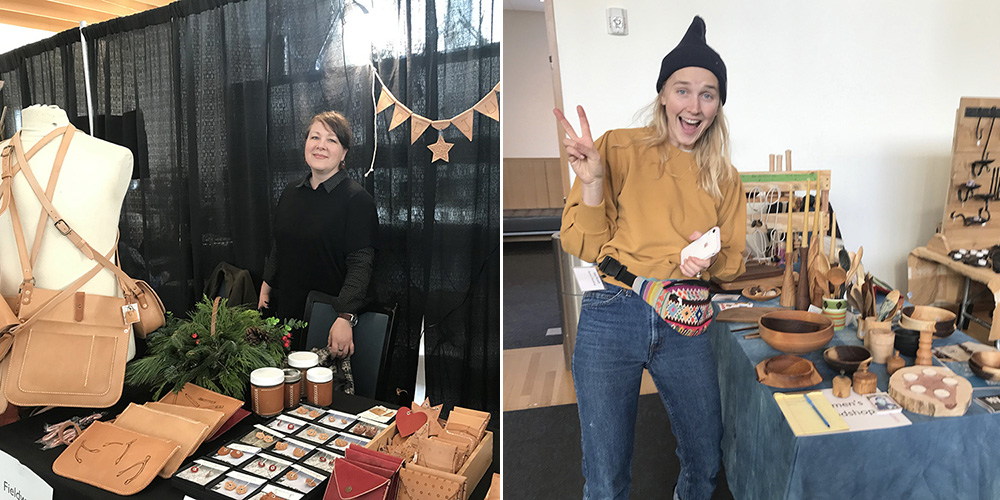
Beth Dow, Jess Hirch
Before going to the sale, I struggled over how to price my things. Like so many craft people, it is challenging to find the tender balance of pricing things to be respectful of the time it takes to make and what people are willing to spend. Of course, there is so much beyond just the effort of making the item. It is easy to forget to consider the cost of the material, the time it takes to acquire and prepare the materials, pricing and packaging the item, marketing, packing it up, making a trip to the city, hanging out in a booth for 3 days... and then there is the clean up, travel home and unpack. I am often pricing things lower than what I wish, sympathizing with the buyer and still embarrassed with the high price of my work.
The question arises frequently for me, “Can I make a living at being an artisan?” Most often I slide into the negative and feel a sense of impossibility. These thoughts are then weighed against the pleasure of making things, being my own boss and being creative. Then the question is re-formed into “Is it worth doing?” Is it a pleasure for me to choose MAKING as a WAY OF LIFE and accept the many other requirements of being self employed. Then the question becomes, “If I feel it is worth it, how can I make it possible?”
Related to this idea of “Making It”, there was a crew from the Duluth PBS show called Making It Up North, that spent a day with the four Artisan Development Program artists, capturing us in our studio space, doing what we do. Karen Sunderman, the producer and interviewer of this wonderful program that captures the stories of creatives, made the filming painless and produced a very sweet piece that is a pleasure to watch. There was a moment in the final scene where I made the statement “I’d chose making it over anything else”. I really have no recollection of saying this and I wonder if the magic of editing clipped this to make me proclaim such a statement! But...If I stop to think about it, yes, it is true, I have always chosen a path of creative employment, mixing art, craft, teaching, living frugally, growing food, bartering and keeping my needs minimal so my financial demands don’t require a substantial income.
Click here to view the episode.
And lastly, here is an update:
Re-evaluate my Closet: A monthly documentation of my attempts to reduce dependence upon synthetic fabrics and factory made items, by using wool to make what I need.
I’m happy to say there are a couple of new felted items that are in my closet, replacing whatever I have purchased from the second hand store.
A felted bag, made from a felted rug in a class with Mary Reichert, a coffee mug cozy that will protect my favorite mug and a few pieces of clothing.
I pulled out a few garments I made years ago but have never worn. I realized that they needed to be re-felted to be sturdier and stretched/sculpted to improve their shape. I continue to learn that I often need to push my felting further than I am used to doing, increasing the demand of patience, time and being a bit more fastidious.
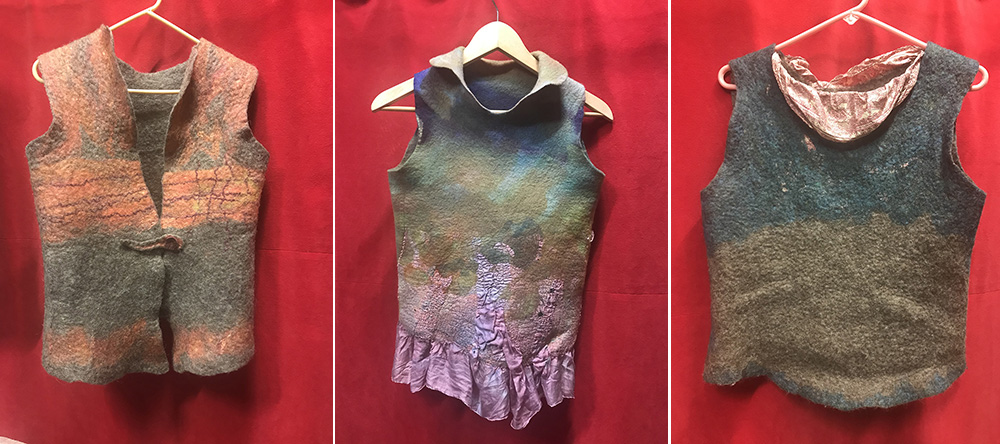
Just before the school break, Mary MacDonald, Kay Rosenthal of the Northwoods Fiber Guild and, and Elly Ray, a 15 year old volunteer and I led a felting workshop at the ISD 166 community day. They had a great time playing with colorful wool, needle felting ornaments and needle felting small sculptures. It was a sweet confirmation that nearly all of the students that chose to be at this workshop, had experienced felting with me the previous year at the North House Folk School Textile Traditions class for Cook County 5th graders. In early February I look forward to teaching the Textile Traditions class again, as well as a new class called felting dioramas for adults and an after school felting class at North House Folk School.
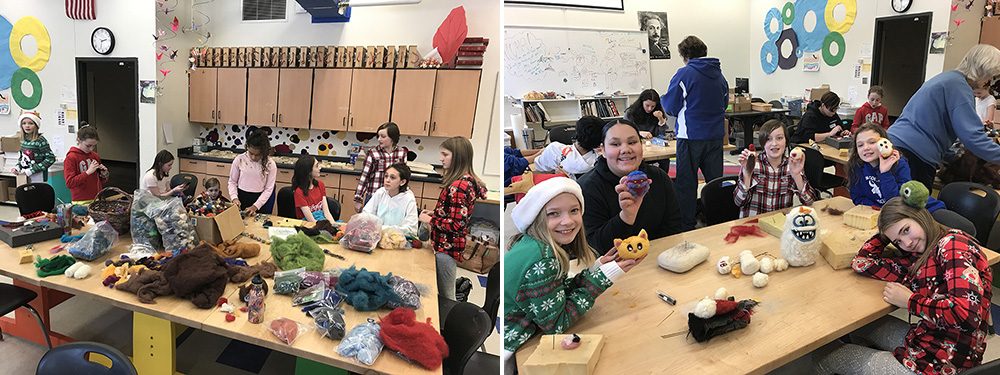
I am now one year into the Artist Development Program and excited to discover what the next year holds. I am so thankful to have this time and the resources to allow myself to experiment without financial stress, to have a beautiful studio space in Betsy Bowen’s old church and to share this with others who are on a similar quest. Perhaps true to any quest, it should be riddled with mysteries, challenges and endless questions to answer and explore. I guess it is true, “I’d choose making it over anything else.”